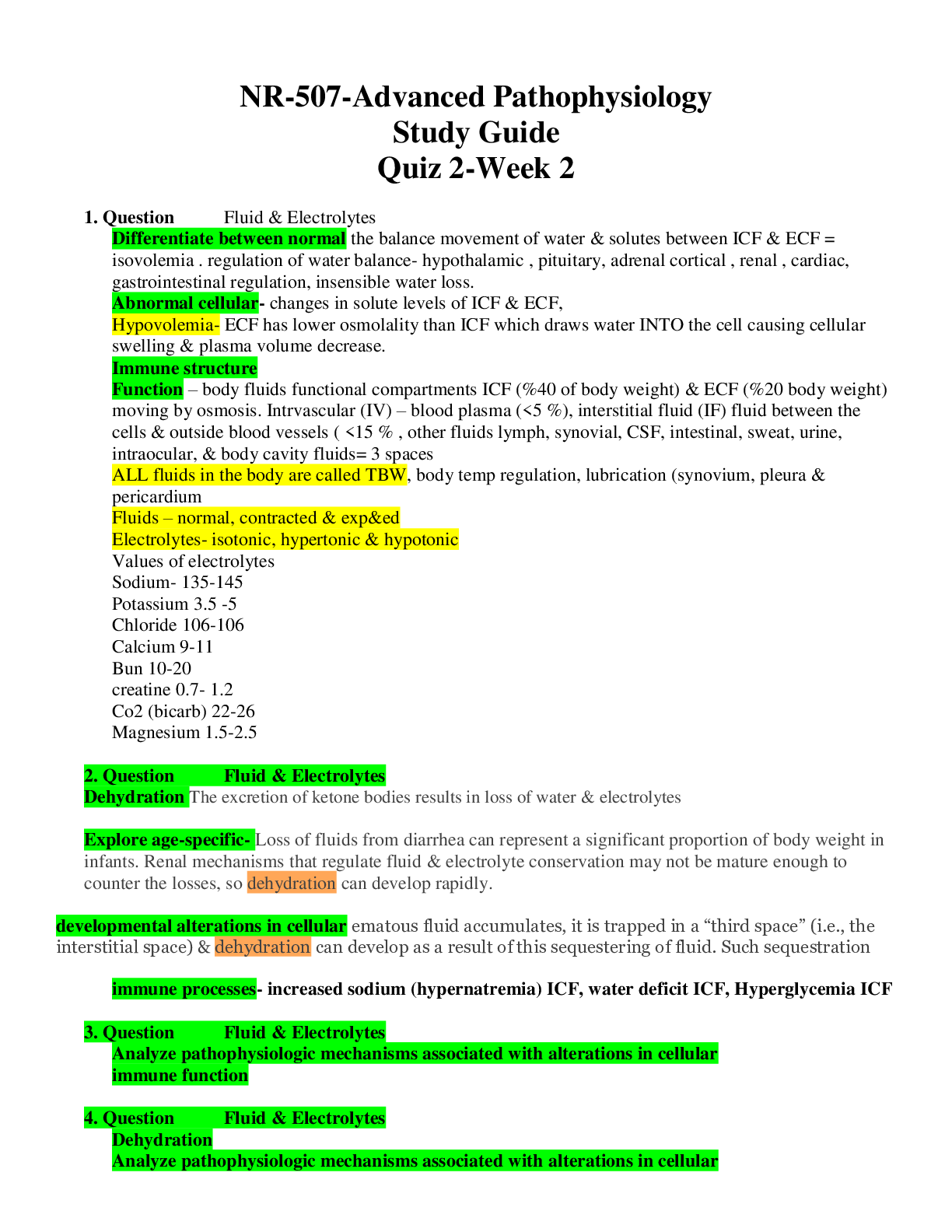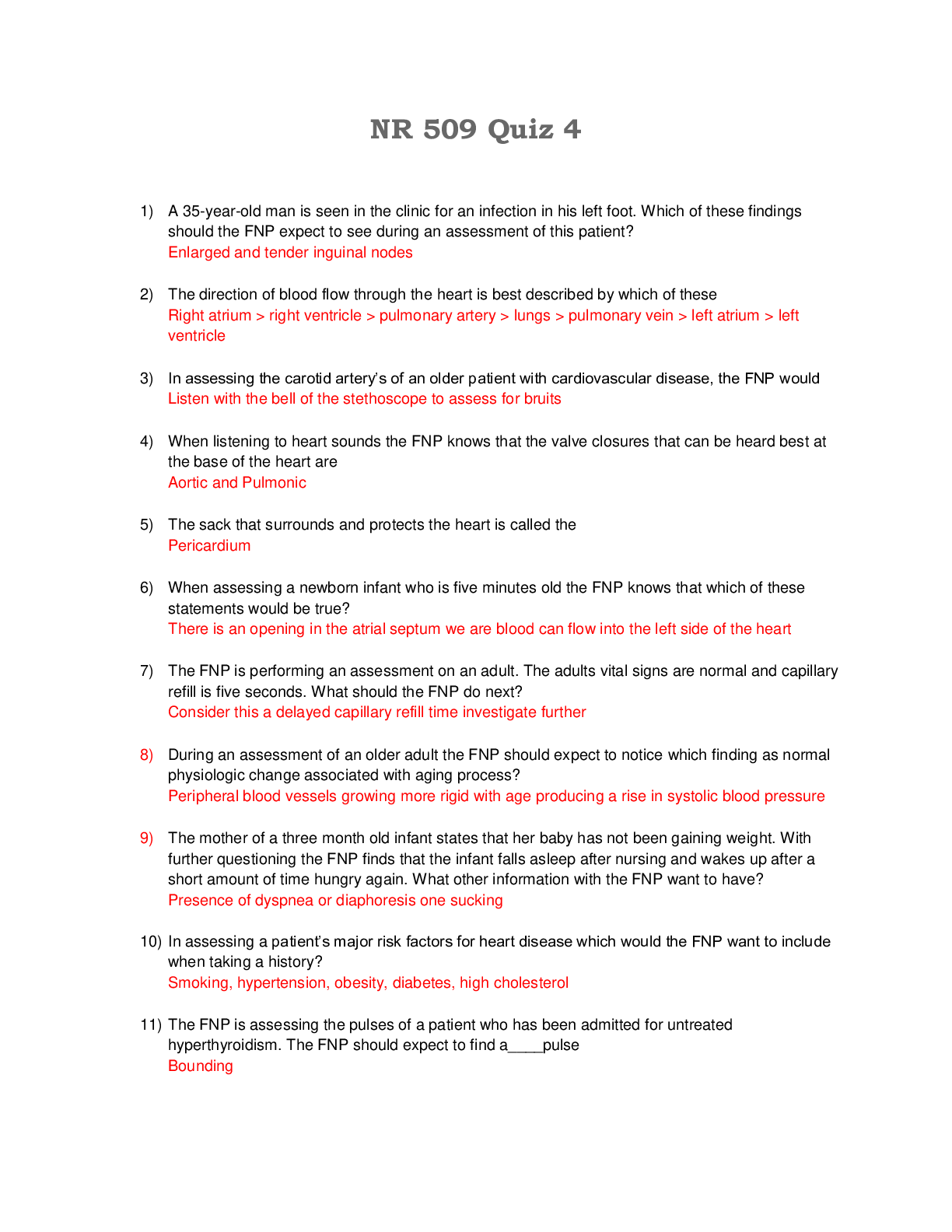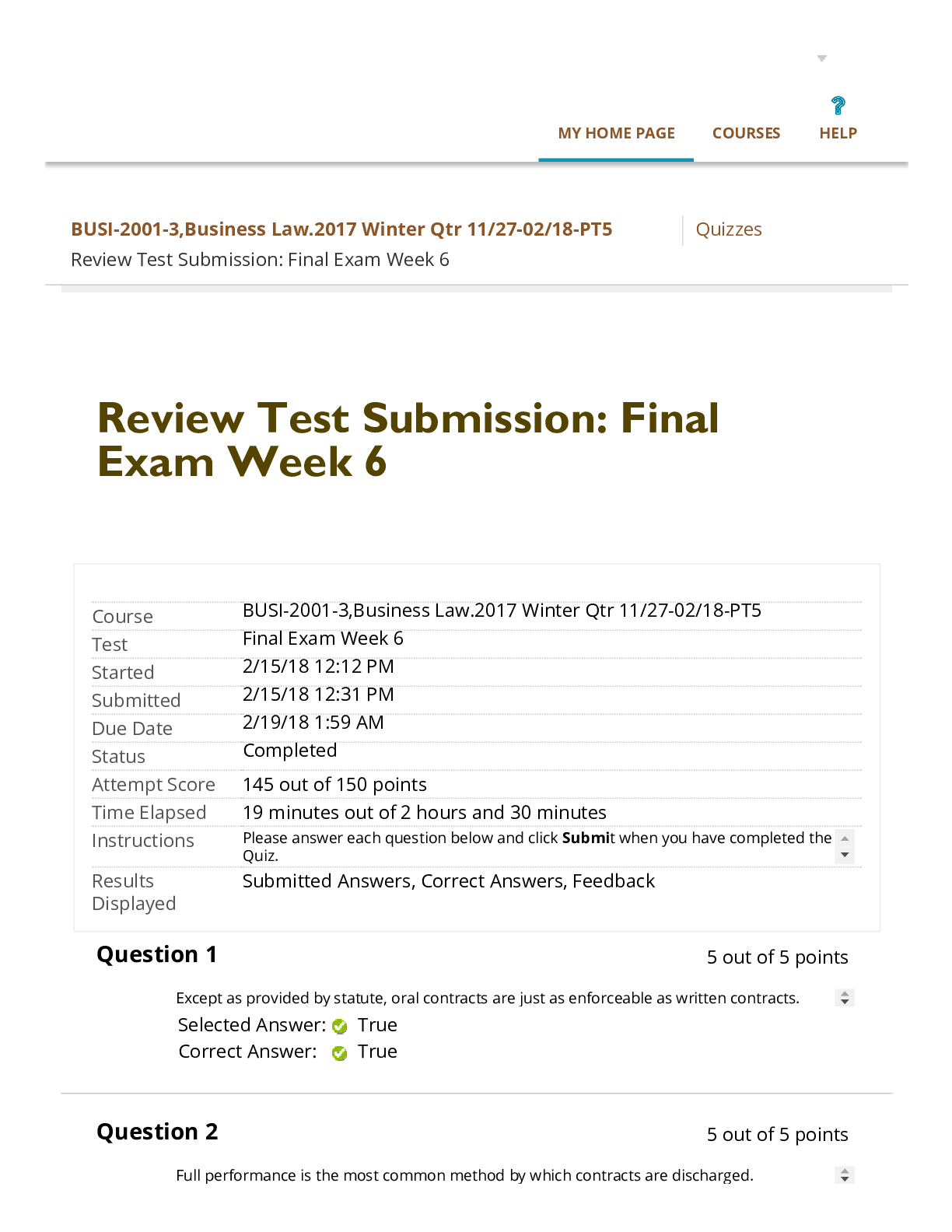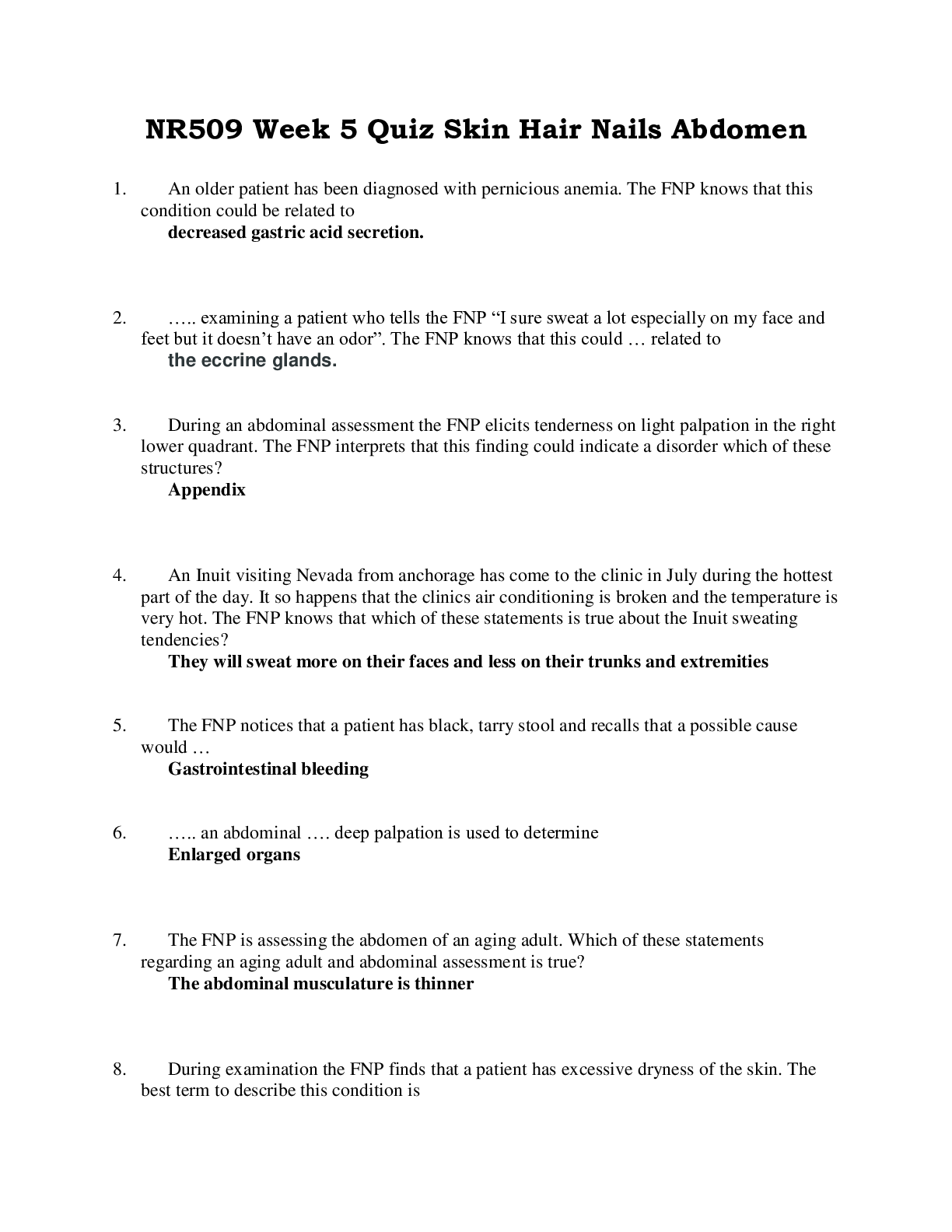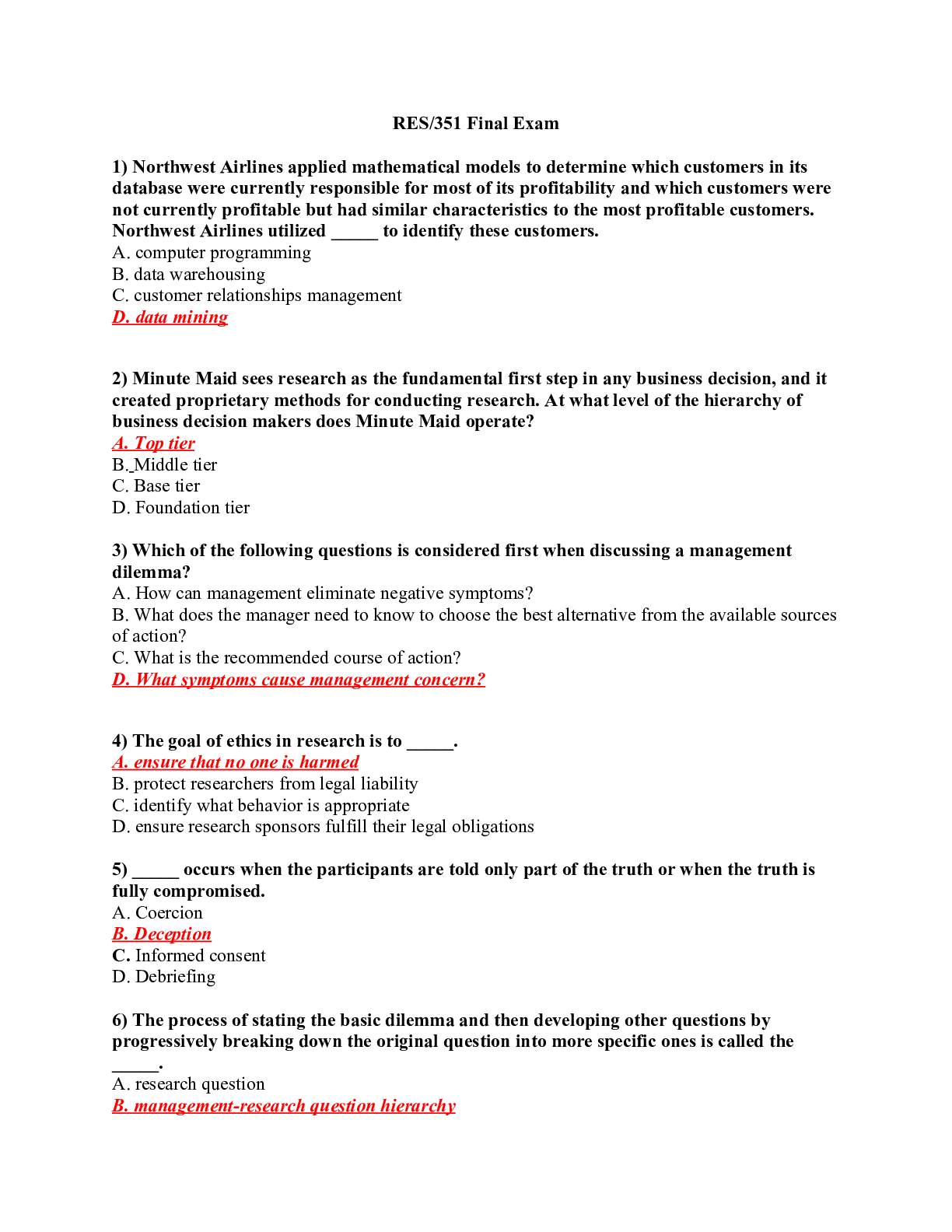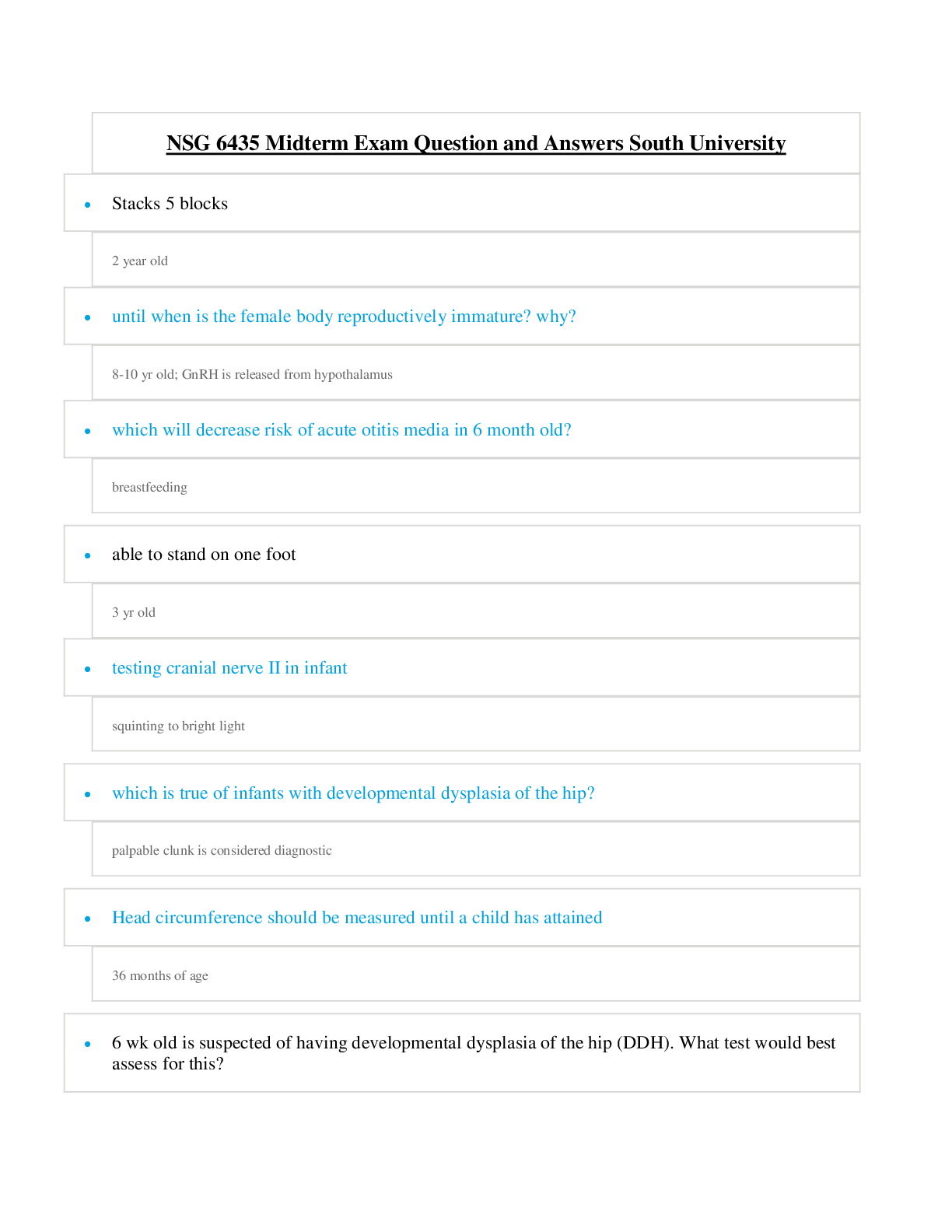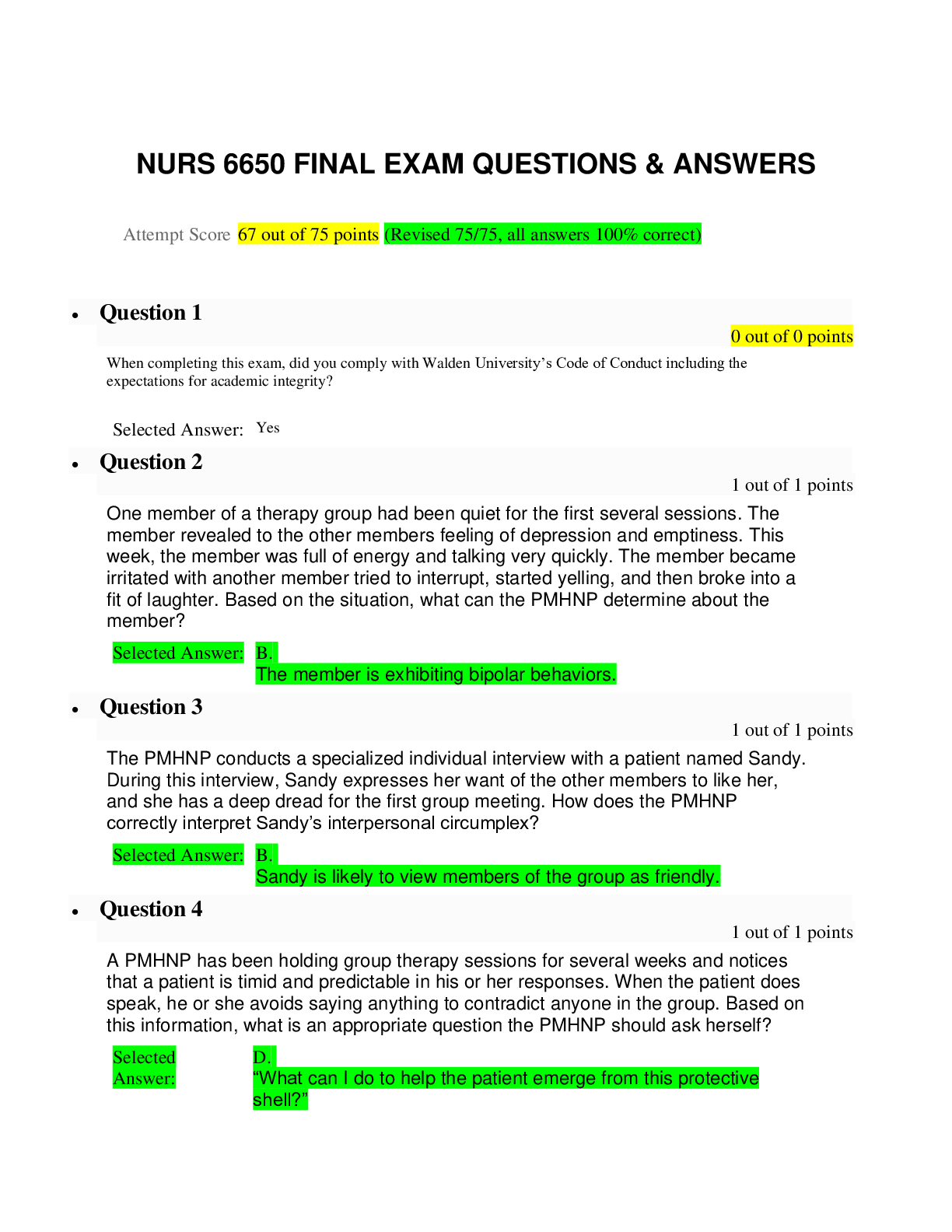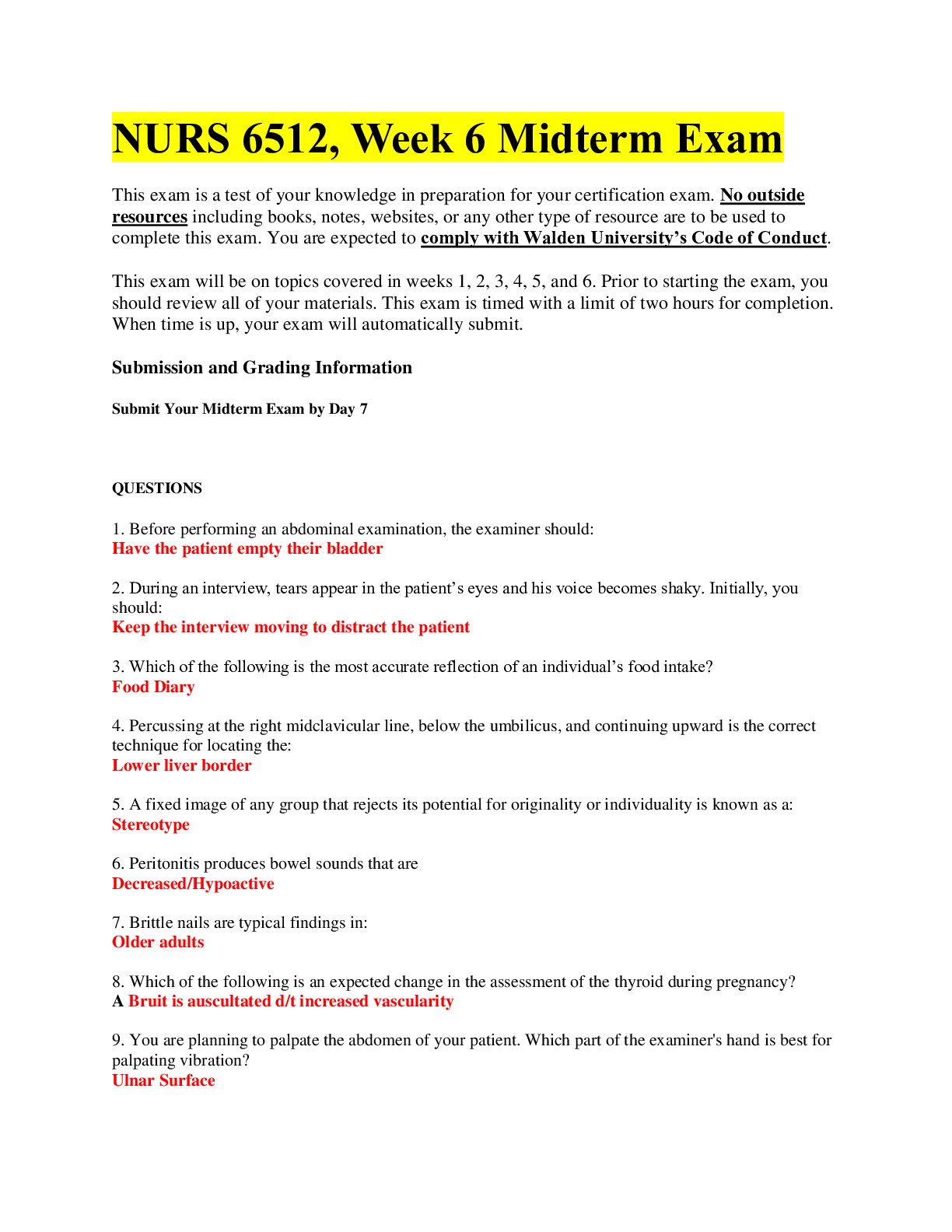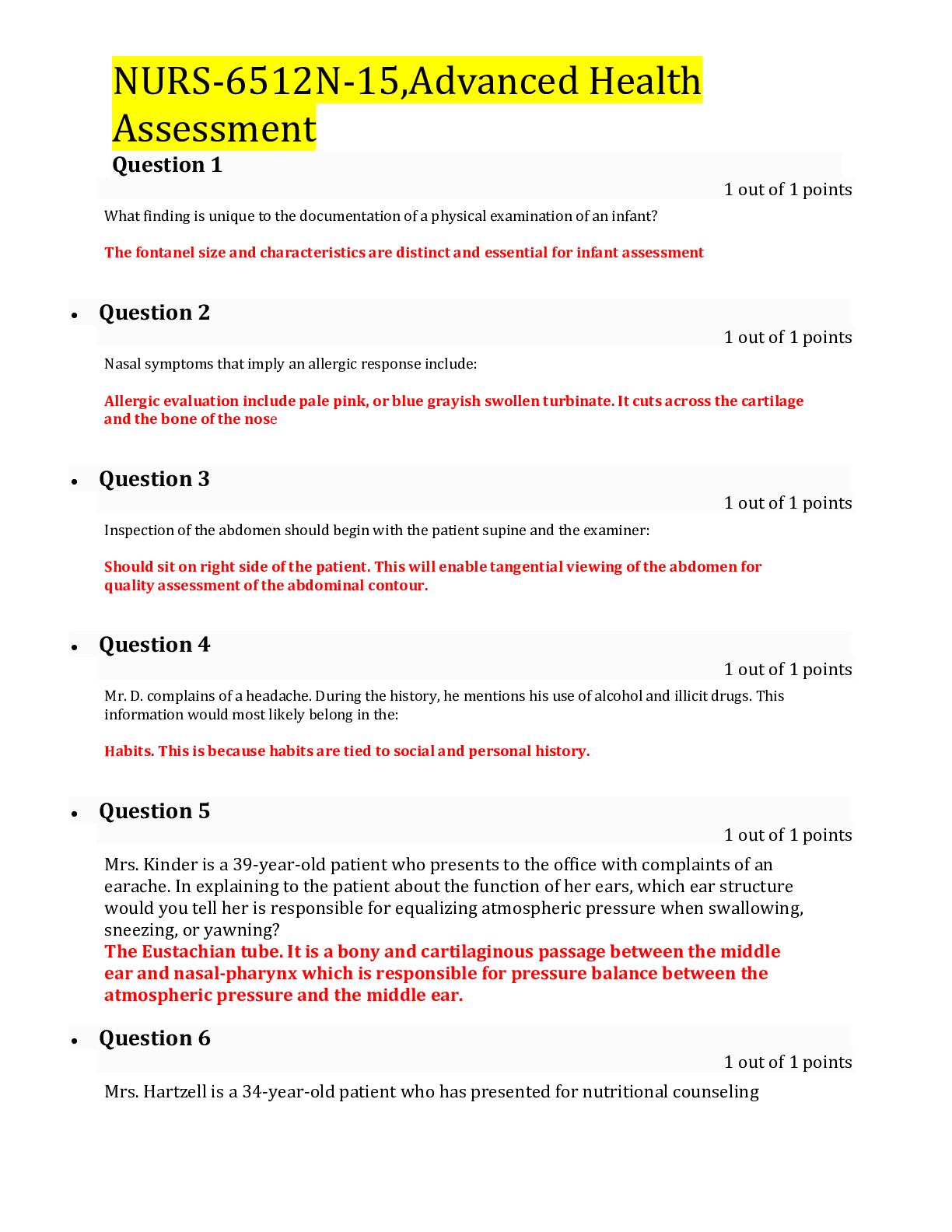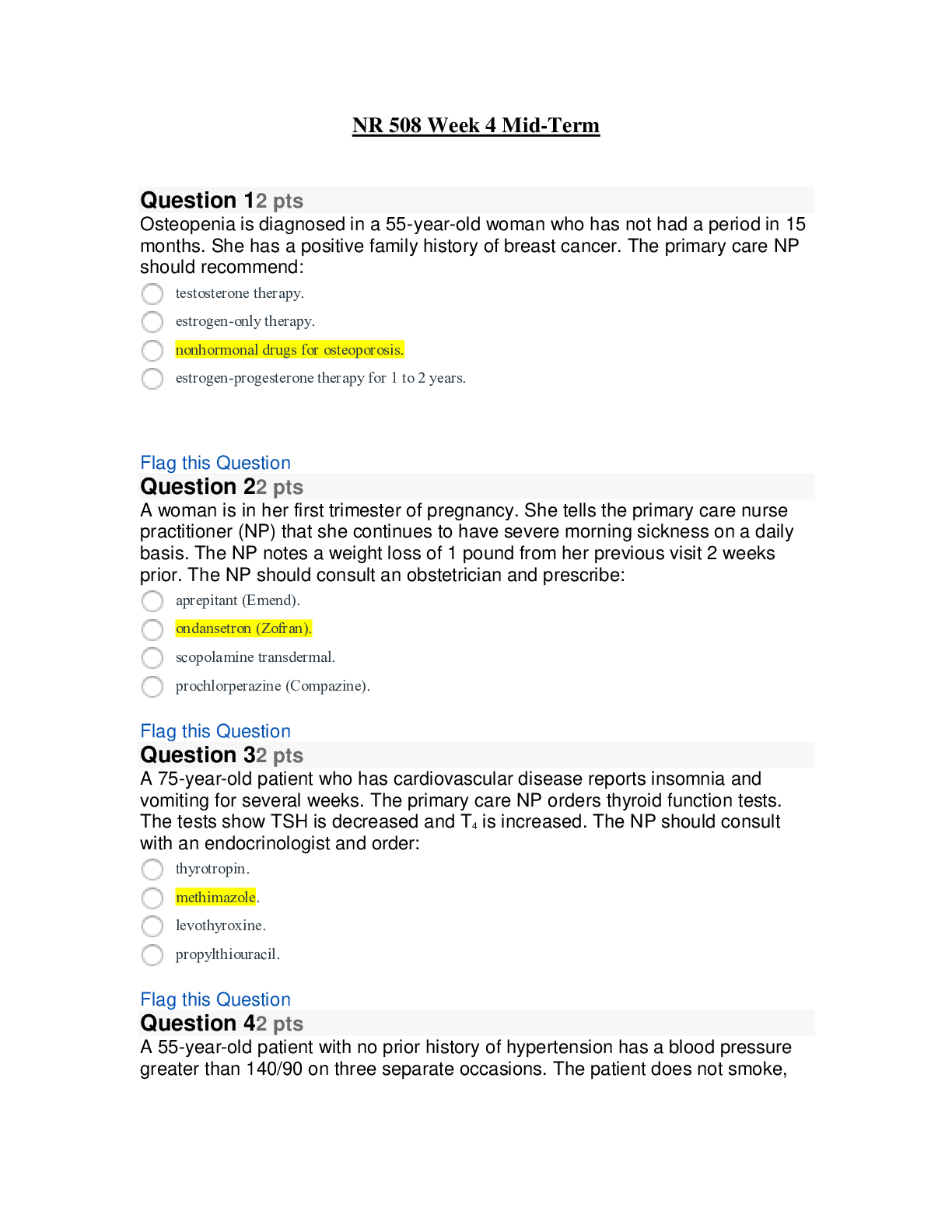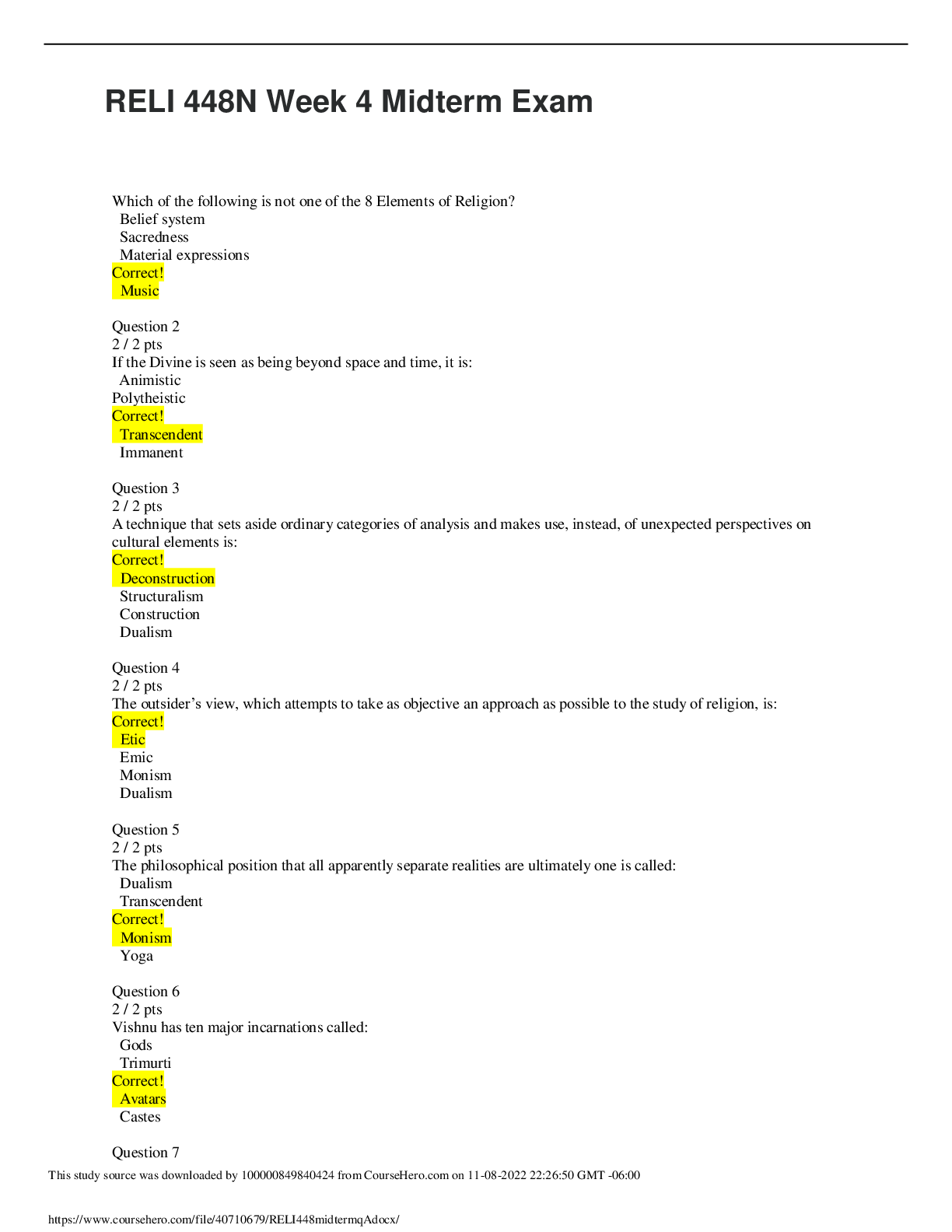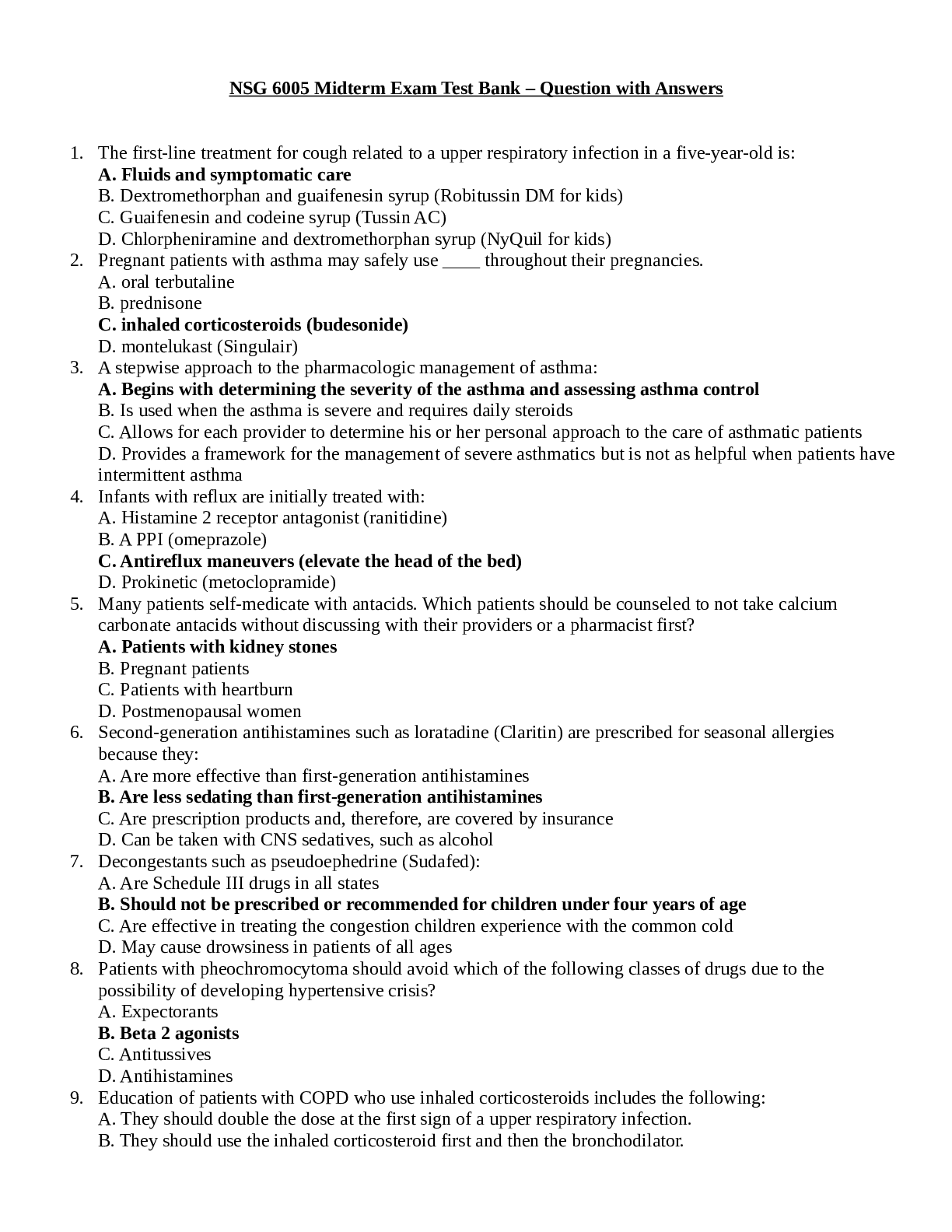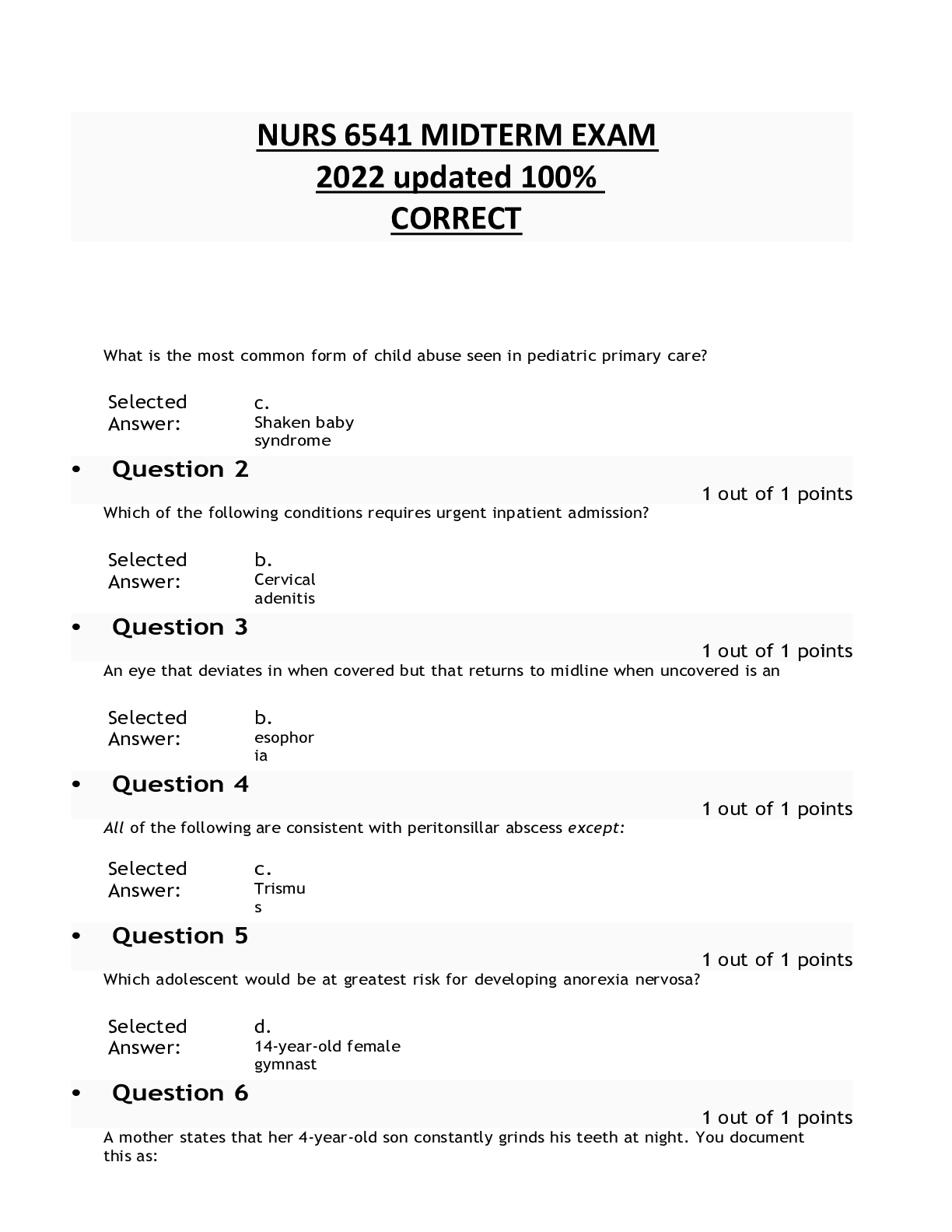NSG 6001 Midterm Exam Question and Answers
Document Content and Description Below
NSG 6001 Midterm Exam Question and Answers 1. Question : Your patient is morbidly obese and cannot sit on a bicycle or walk a treadmill. She also has marked and severe emphysema. You need to make an... assessment of the risk of significant CAD and your patient’s family says that their relative had their diagnosis based on an ultrasound echocardiography. What facts would influence your decision regarding the family request for echo assessment? Student Answer: Specificity would be increased because of obesity Sensitivity would be reduced because of obesity and lung disease (Sensitivity would be reduced because of obesity and lung disease.) Sensitivity would be increased because of lung disease Specificity would be reduced because of obesity and lung disease 2. Question : Medicaid is mandated to be provided by each state through federal codes. Each state must offer Medicaid exactly as the federal government prescribes. True or false? Student Answer: False (Medicaid is mandated to be provided by each state, however, Mediciad is not required to be delivered by any certain formula. Each state has autonomy to deliver Mediciad services under its own guidelines, provided that each state meets the federal guidelines for Medicaid coverage. ) True 3. Question : By standard criteria, how is a positive stress test defined? Student Answer: Development of a horizontal or down sloping ST-segment depression of 10mm Development of a horizontal or down sloping ST-segment depression of 1mm (A positive stress test is defined as the development of a horizontal or down sloping ST-segment depression of 1mm. ) Upward sloping ST-segment measured at the J point of the QRS Down sloping of the ST-segment at the J point of the QRS 4. Question : Population disease management is a term used to describe: Student Answer: Low prevalence specific diseases High prevalence specific diseases (Population disease management is a term used to describe the high prevalence of specific diseases. ) Low specificity diseases states High specificity disease states 5. Question : What are two of the most common forms of Exercise Stress Tests used today? https://www.coursehero.com/file/52531152/NSG-6001-Midterm-Exam-Question-and-Answerspdf/ This study resource was shared via CourseHero.comStudent Answer: Bicycle and treadmill (Bicycle and treadmill are the two most common forms of exercise stress tests used today. ) Unicycle and Running in pace Thallium and Dobutamine Bicycle and rowing machine 6. Question : You are counseling a patient diagnosed with stress-induced ischemia. You base your discussion on your knowledge that stress-induced ischemia is thought to be caused by what phenomena? Student Answer: Too many carbonated drinks Diet and exercise Endothelial dysfunction of the microvascular (You base your discussion on your knowledge that stress-induced ischemia is thought to be caused by endothelial dysfunction of the microvascular.) Heart muscle dysfunction 7. Question : Narrowed coronary arteries or plague rupture within the arteries of the coronary system may directly cause which condition? Student Answer: Venous Statis Diabetes Hypertension Coronary artery disease (Narrowed coronary arteries, plague rupture, and sometimes even spasms of the coronary arteries are the three most common direct causes for the diagnosis of coronary artery disease. ) 8. Question : Of the following, which is the best answer when asked for an advantage of echocardiogram exercise testing over thallium stress testing? Student Answer: Results are available more quickly (Echocardiogram exercise test results are available more quickly.) Does not depend on operator experience Doesn’t matter because there are no advantages Costs are the same 9. Question : A 55-year old man is referred to your clinic. He has been sedentary all of his life, is gaining weight and wishes to get into better physical shape. He has never had any chest pain or shortness of breath when walking or climbing a flight of stairs. Before recommending a vigorous exercise routine for this patient, you order what test? https://www.coursehero.com/file/52531152/NSG-6001-Midterm-Exam-Question-and-Answerspdf/ This study resource was shared via CourseHero.comStudent Answer: Stool samples CBC ETT (Many patients have underlying CAD but remain asymptomatic. Before beginning any new vigorous activities after years of sedentary lifestyle, it is recommended that the patient obtains an ETT to rule out underlying CAD.) Thyroid levels 10. Question : What ECG changes can reduce the specificity of the ETT? Student Answer: Paced rhythm and resting bundle branch block (The ECG changes that can reduce the specificity of the ETT are paced rhythm and resting bundle branch block. ) Low voltage up sloping of the ST-segment Exercise induced bundle branch blocks Paced rhythm and exercise induced bundle branch blocks 11. Question : In women, you need to know the limitations of certain tests for CAD. For example, single-photon emissions CT imaging, while an acceptable test for most men and some women, is technically limited in women for two reasons. From the following, choose the best possible answer. Student Answer: Breasts and fat deposits in abdomen Smoking rates and lack of uptake of photons Breasts and smaller coronary arteries (Single-photon emissions CT imaging is technically limited in women due to breasts and smaller coronary arteries.) Multiple vessel disease and fat deposits 12. Question : Improvements in the delivery and management of healthcare are necessary if we are to improve the overall health of this nation’s population. Which of the following are identified in your readings as strategic in the movement to improve the healthcare system? Student Answer: Monetary savings and limited disruption in healthcare delivery Population management and healthcare practice (Population management and healthcare practice are strategic in the movement to improve the nation’s healthcare system. ) Socialized medicine and governmental controls President and Congress https://www.coursehero.com/file/52531152/NSG-6001-Midterm-Exam-Question-and-Answerspdf/ This study resource was shared via CourseHero.com13. Question : The sensitivity of a routine ETT is effort dependent. What physiological changes occur during effort in the routine ETT? Student Answer: Decrease in coronary blood flow Increased coronary flow and increased systolic blood pressure (The physiological changes that occur during effort in the routine ETT are increased coronary flow and increased systolic blood pressure.) Rapid heart rates and coronary artery narrowing Decreased heart rate and increased systolic blood pressure 14. Question : Your mentor says that you should be prepared to know how to determine the maximum heart rate for your patient during the ETT. How is the age-predicted maximum heart rate during an ETT determined? Student Answer: 220+age 120-age 220-age (The age-predicted maximum heart rate during an ETT determined by subtracting the patient’s age from 220 (220 – age). ) 65+age 15. Question : Medicare hospital insurance (Part A) is funded through what system? Student Answer: Interest from investments State income taxes Federal income taxes Federal payroll taxes (Medicare Part A is funded through federal payroll taxes. ) 16. Question : We all know that collaboration is integral to becoming a successful nurse practitioner. Among collaborations, however, only one can be considered as the most important. While each example below is important, which is the most important collaboration? The one that occurs: Student Answer: Between the patient and their family Between the patient and the nurse practitioner (The collaboration that is most important is the one that occurs between the patient and the nurse practitioner. ) Between the nurse practitioner and their physician mentor Between two healthcare providers about a single patient https://www.coursehero.com/file/52531152/NSG-6001-Midterm-Exam-Question-and-Answerspdf/ This study resource was shared via CourseHero.com17. Question : The leads on the ECG showing ischemic changes during or immediately after an ETT can correlate roughly to the culprit artery or arteries with significant CAD. Is this true or false? Student Answer: False True (This statement is true: the leads on the ECG showing ischemic changes during or immediately after an ETT can correlate roughly to the culprit artery or arteries with significant CAD. ) 18. Question : Ischemic changes on ECG during ETT is highly predictive of CAD. What is another important strong predictor of CAD that you might see during an ETT? Student Answer: Slow heart rate Exercise-induced hypotension (Another important strong predictor of CAD that you might see during an ETT is exercise-induced hypotension. ) Exercise-induced hypertension Rapid heart rate 19. Question : In CAD, after both systolic and diastolic dysfunction have occurred, the typical pattern of chest pain and related EKG changes occur. During an EKG, you should expect to see ST-segment and T-wave changes that are central to demonstration of ischemia occurring relatively late in the ischemic cascade. Is this true or false? Student Answer: False True (This is a true statement. During an EKG, you should expect to see STsegment and T-wave changes that are central to demonstration of ischemia occurring relatively late in the ischemic cascade. ) 20. Question : Chronic, non-communicable diseases account for disproportionate costs to the healthcare system. According to the World Health Organization, what percent of preventable deaths and disabilities occur in the Americas related to chronic noncommunicable diseases? Student Answer: 10%-15% 80%-90% 35%-45% 60%-70% (According to the World Health Organization, 60%--7 0% of preventable deaths and disabilities occur in the Americas related to chronic noncommunicable diseases. ) 21. Question : Your patient has a maximum age-predicted heart rate of 180. During the exercise, he reaches a heart rate of 140 and then states he can no longer exercise. You see no evidence of ischemia on the ECG. This would be diagnostic for what condition? https://www.coursehero.com/file/52531152/NSG-6001-Midterm-Exam-Question-and-Answerspdf/ This study resource was shared via CourseHero.comStudent Answer: Has no diagnostic value to rule out CAD (This scenario has no diagnostic value to rule out CAD.) Predictive of no CAD Diagnostic of laziness Diagnostic for impending Myocardial Infarction 22. Question : What happens to coronary flow related to CAD? Student Answer: Functional systolic pressures Hyper profusion of the myocardium Cerebral vascular infarction Hypo profusion of the myocardium (Because of the restrictive flow of blook through the coronary ateries,hypo profusion of the myocardium results from coronary flow related to CAD which causes the presenting symptoms. ) 23. Question : Your patient cannot sit on a bicycle and has difficulties walking a treadmill with limited capacity for exercising. Still, you know that the ETT is the preferred test for CAD. You consider adding a pharmacological agent to get to maximum heart rate. What agent would be the most commonly used agent to assist in an ETT? Student Answer: Epinephrine Dobutamine (The pharmacological agent most commonly used to assist in an ETT is dobutamine.) Dopamine Aspirin 24. Question : A 47-year old female with general complaints of fatigue and shortness of breath shows up in your clinic as a referral from another nurse practitioner. Several blood tests and chest x-rays have been completed without any diagnosis or outstanding abnormalities. You decide to order an ETT despite the fact that the recent ECG does not show any abnormalities. From the answers below, which would be the best answer to support your decision? Student Answer: To please the patient CAD in women is under diagnosed (You make this choice because you are aware that CAD in women is under diagnosed.) Women present with the same pattern of CAD as do males You are out of other options 25. Question : Why would inability to exercise reduce the specificity of the routine ETT? https://www.coursehero.com/file/52531152/NSG-6001-Midterm-Exam-Question-and-Answerspdf/ This study resource was shared via CourseHero.comStudent Answer: Produces persistent ST-segmental changes and T-wave abnormalities (The inability to exercise reduces the specificity of the routine ETT because it produces persistent ST-segmental changes and T-wave abnormalities. ) Will not produce any changes in ECG Produces QRS changes that cannot be interpreted Causes ST-segment changes and P-wave abnormalities 26. Question : On the echocardiography during the ETT you notice the following change: abnormal left ventricular ejection fraction. What do these changes suggest related to this patient? Student Answer: Ischemia of the myocardium (Abnormal left ventricular ejection fraction suggests ischemia of the myocardium.) Weak ventricular muscles Rise in heart rate without evidence of ischemia Non-ischemic changes of the baseline ECG 27. Question : Specifically, when is an ETT considered to be negative? Student Answer: Patient exercises to 20% maximum age-predicted heart rate without induced ischemia Patient exercises to 85% of age predicted maximum heart rate without evidence of induced ischemia (An ETT is considered to be negative when the patient exercises to 85% of age predicted maximum heart rate without evidence of induced ischemia. ) Patient exercises until tired without evidence of induced ischemia Patient has ST-segmental changes with down sloping of greater than 1 mm at 50% of age-predicted maximum heart rate 28. Question : Eligibility for Medicaid includes the following: Student Answer: Elderly, children and women living in poverty (Eligibility for Medicaid includes the elderly as well as children and women living in poverty. ) Very young and elderly only Everyone unemployed Children and women regardless of income 29. Question : What is the leading cause of death for women in the United States? Student Answer: Complications of childbirth https://www.coursehero.com/file/52531152/NSG-6001-Midterm-Exam-Question-and-Answerspdf/ This study resource was shared via CourseHero.comLung cancer Breast cancer Heart disease (Heart disease is the leading cause of death for women in the United States.) 30. Question : What do you know regarding ischemia that is confined to only the posterior and or lateral segments of the left ventricle? Student Answer: Requires both for detection of changes by ETT Easier to detect by ETT Difficult to detect by ETT (Ischemia that is confined to only the posterior and or lateral segments of the left ventricle is difficult to detect by ETT, but that does not mean that ETT cannot detect ischemia limited to these functional areas of the heart. [Show More]
Last updated: 1 year ago
Preview 1 out of 8 pages
Instant download
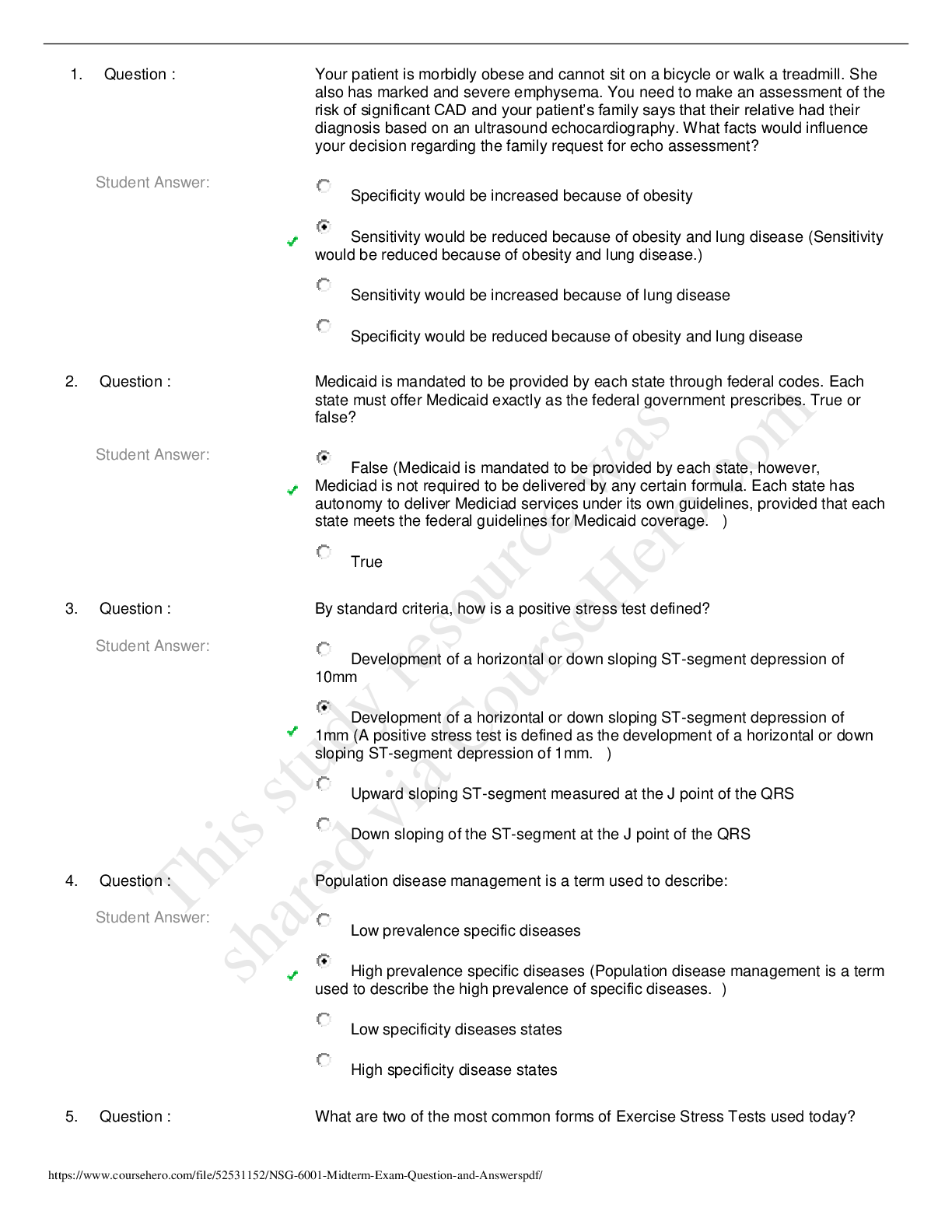
Buy this document to get the full access instantly
Instant Download Access after purchase
Add to cartInstant download
Reviews( 0 )
Document information
Connected school, study & course
About the document
Uploaded On
Mar 03, 2022
Number of pages
8
Written in
Additional information
This document has been written for:
Uploaded
Mar 03, 2022
Downloads
0
Views
38

